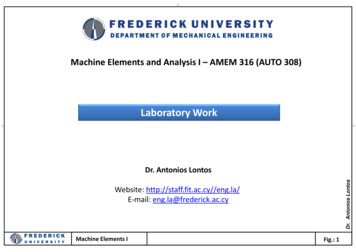
Transcription
AN607Vishay SiliconixDC-to-DC Design GuideSerge Jaunay, Jess BrownINTRODUCTIONManufacturers of electronic systems that require powerconversion are faced with the need for higher-density dc-to-dcconverters that perform more efficiently, within a smallerfootprint, and at lower cost—despite increasing output loads.To meet these demands, Siliconix has combined advancedTrenchFETR and PWM-optimized process technologies,along with innovative new packages, to provide:D lowest on-resistance for minimum power dissipationD lowest gate charge for minimum switching lossesD dV/dt shoot-through immunity1D improved thermal management.Breakthroughs in thermal management for increasing powerdensity are being achieved with Vishay Siliconix packagingtechnologies such as the PowerPAKt (Si7000 Series), thethick leadframe D2PAK (SUM Series), and ChipFETt (Si5000Series).D The PowerPAK SO-8 offers the steady-state thermalresistance of a DPAK in an SO-8 footprint.D The PowerPAK 1212-8 is approximately half the size of aTSSOP-8 while decreasing the thermal resistance by anorder of magnitude.D The SUM Series reduces thermal resistance by 33% overstandard D2PAK packaging.D ChipFET is 40% smaller than a TSOP-6 package whileoffering lower on-resistance and lower thermal resistance.It should be noted that lower thermal resistance results inhigher possible maximum current and power dissipation.The complete array of Vishay Siliconix MOSFET-packagedproducts ranges from the D2PAK (SUM or SUB series), DPAK(SUD Series), and PowerPAK (Si7000 Series) types ofpackages to the LITTLE FOOTR packages. These smalloutline devices range from the SO-8 down to the tiniestMOSFET available - the LITTLE FOOT SC-89.BACKGROUND MATERIALSwitching CharacteristicsThe basic characteristics of a MOSFET are key tounderstanding how these devices work in switchmode powersupplies.In reality the freewheel diode will have some form of reverserecovery effect ( a and b, Figure 2), and as a result, thecurrent through the drain source of the MOSFET (Q1, Figure1) will increase. To accommodate the extra drain-sourcecurrent, VGS must increase above the value necessary tosupport the load current. The gate voltage keeps rising until thedevice is carrying the combined load and recovery current(period ). Therefore, the recovery current of the freewheeldiode adds to the load current seen by the controlling MOSFET(Q1). At the end of period a, the reverse recovery currentfalls, along with the gate-source voltage. This is because thediode has recovered. The recovery current in turn will decay tozero, resulting in the gate voltage reducing to the original valuerequired to support the load current (period b). During thisperiod, the freewheel diode starts to support voltage, and theVDS voltage falls, and the Miller Plateau begins. As with theideal-recovery diode explanation, this continues until thevoltage falls to its on-state value (end of ) and thegate-source voltage is unclamped and continues to theapplied gate-voltage value.Turn-off is effectively the reverse of turn-on, apart from thatthere is no limitation by the freewheeling diode (in thisparticular circuit). For turn-off the Miller Plateau indicates thestart of the rise of the drain-source voltage, and the voltage ofthe Miller Plateau will represent the required VGS to sustain theload current. The turn-off delay is the period from when thegate voltage falls from its on-state value to when it reaches theMiller Plateau value (i.e. load-current value).A simple buck converter, shown in Figure 1, shows thebehavior of the MOSFET during turn-on and turn-off whenswitching an inductive load. During these periods, a positivestep input is applied to turn the device on, and a step transition,from positive to zero, is applied to turn the MOSFET off.With a positive step-input voltage on the gate, the voltageacross the gate-source of the MOSFET (VGS) ramps upaccording to the time constant formed by the gate resistance(Rg) and input capacitance (Ciss), as shown in Figure 2a(period ¡). Once VGS reaches the threshold voltage (Vth), thechannel is turned on, and the current through the device startsto ramp up (period ). At the end of period , there are twopossible switching transients that VGS could follow. In the firstcase, the freewheel diode (D1, Figure 1) is assumed to havean ideal reverse recovery, represented by the solid waveformsin Figure 2. Once the channel is supporting the full-loadcurrent, the voltage across the device can begin to decay (theend of point ) because the diode is now able to supportvoltage. As the drain-source voltage falls, the gate-sourcevoltage stays approximately constant. This phenomenon iscalled the ”Miller Plateau,” and it continues until the voltagea) Specificallydesigned to prevent spurious turn-on during high rates of dV/dtb) SUMis an improved D2PAK package, with lower rDS(on) and thermalresistanceDocument Number: 7191710-Oct-02www.vishay.com1
AN607Vishay Siliconixfalls to its on-state value. At the end of period (Figure 2), thegate-source voltage is unclamped and continues to theapplied gate-voltage value. This additional gate voltage fullyenhances the MOSFET channel and reduces the rDS(on).In reality the freewheel diode will have some form of reverserecovery effect ( a and b, Figure 2), and as a result, thecurrent through the drain source of the MOSFET (Q1, Figure1) will increase. To accommodate the extra drain-sourcecurrent, VGS must increase above the value necessary tosupport the load current. The gate voltage keeps rising until thedevice is carrying the combined load and recovery current(period ). Therefore, the recovery current of the freewheeldiode adds to the load current seen by the controlling MOSFET(Q1). At the end of period a, the reverse recovery currentfalls, along with the gate-source voltage. This is because thediode has recovered. The recovery current in turn will decay tozero, resulting in the gate voltage reducing to the original valuerequired to support the load current (period b). During thisperiod, the freewheel diode starts to support voltage, and theVDS voltage falls, and the Miller Plateau begins. As with theideal-recovery diode explanation, this continues until thevoltage falls to its on-state value (end of ) and thegate-source voltage is unclamped and continues to theapplied gate-voltage value.Turn-off is effectively the reverse of turn-on, apart from thatthere is no limitation by the freewheeling diode (in thisparticular circuit). For turn-off the Miller Plateau indicates thestart of the rise of the drain-source voltage, and the voltage ofthe Miller Plateau will represent the required VGS to sustain theload current. The turn-off delay is the period from when thegate voltage falls from its on-state value to when it reaches theMiller Plateau value (i.e. load-current value).LQ1VIND1CVOUTFIGURE 1. Typical circuit of a buck converterFIGURE 2. Switching waveforms for a typical MOSFET in a buck converterNote: The solid line shows an idealized curve with no recoveryof the anti-parallel diode. The dotted line shows the effect ofwww.vishay.com2reverse recovery of the freewheel diode on the gate waveformand the corresponding switching waveforms.Document Number: 7191710-Oct-02
AN607Vishay SiliconixDriving MOSFETs: N- and P-Channel.a) use an isolated supply with the 0 V referenced to thesource voltage to ensure that the applied VGS is thesame as the voltage driving the gate;There are two fundamental types of MOSFETs: n-channel andp-channel. An n-channel device needs a positive gate voltagewith respect to the source voltage, whereas a p-channelMOSFET requires the gate voltage to be negative with respectto the source. Due to these criteria, each device sometimesappears to be geared for specific applications, such asp-channels for load switches and n-channels for low-sideswitches. In reality it is only the drive circuits that need to bedifferent.b) use a charge-pump circuit that generates a voltage higher than the dc-link voltage to drive the gate; orDVGSGVSSFIGURE 3. Schematic of an n-channel MOSFETSSVGVGSc) use a bootstrap circuit that again generates a voltagehigher than the dc-link voltage, but which requires aswitching circuit to charge up the bootstrap capacitorafter the top device is turned off.Another method is to use a p-channel device in situations inwhich the gate voltage does not need to be higher than thedc-link voltage. This is appropriate when the drain voltage ofthe MOSFET is less than 20 V because the gate signal can bederived directly from the input signal. With dc-link voltages 20V and with limitations of » 20 V on maximum gate voltages, itis necessary to level-shift the applied gate voltage to ensurethat the gate voltage does not exceed the maximum value.Therefore, with a dc-link voltage of 50 V, the applied gatevoltage must be level-shifted to at least 30 V. It should also benoted that the performance characteristics of a p-channelgenerally are inferior to those of an n-channel due to thephysical structure of the device.For low-side devices, it is generally accepted that n-channeldevices are used because the source connection of theMOSFET is connected to power ground. As such, then-channel MOSFET only will require a positive signalreferenced to power ground, whereas a p-channel devicewould require a negative signal to ground to keep the deviceturned on.Synchronous RectificationDFIGURE 4. Schematic of a p-channel MOSFETFor the high-side switch portrayed in the buck converter ofFigure 1, it would be possible to use either a p- or n-channeldevice; however, the operating conditions of the buckconverter will determine which is to be used.Again, consider the high-side MOSFET as shown in Figure 1.Once it is turned on, the source voltage will tend towards thedrain voltage (minus the voltage across the device Vs»Vd).Therefore, if the gate drive is generated from the input voltage(Vin) as the MOSFET turns on, VGS will reduce as the sourcepin (Vs) goes to Vin (Vd).For an n-channel device, this means that the gate voltage mustbe higher than the drain voltage to maintain VGS above theMiller Plateau voltage to ensure that the MOSFET stays fullyon. To achieve this there are three common strategies orcircuits:Document Number: 7191710-Oct-02Improvements in efficiency can be made by replacing therectifying diodes, or freewheel diodes, with MOSFETs. This isbecause the MOSFET has the capability to conduct current inboth directions, and reductions in conduction loss can beachieved due to the I2R losses of the MOSFET being lowerthan the IV losses associated with the diode. However, thecircuit and load conditions will determine whether the increasein efficiency offsets the extra cost, and sometimes additionalcircuitry, demanded by synchronous MOSFETs.It should be noted that the freewheel diode (D1, Figure 1), orrectifying diode, is still required to prevent both MOSFETsconducting at the same time -- the necessity of dead timebetween Q1 and Q2 results in a short period of diodeconduction -- and causing shoot-through conditions. However,with the inclusion of a MOSFET, it is possible to use theinherent body diode, though this typically demonstratesperformance inferior to that of an external Schottky diode. Asa result, it is sometimes beneficial to use a Schottky diode asthe anti-parallel diode bypassing the inherent body diode andresulting in an improvement of the conduction and recoveryperformance of the freewheel diode.www.vishay.com3
AN607Vishay SiliconixNON-ISOLATED TOPOLOGIESdi LV Vout inLdtNon-isolated Buck ConverterBasic operation[1]LQ1The buck (or step-down) converter, shown in Figure 5, is usedto convert a positive dc voltage to a lower positive dc voltage.It can be a bi-directional converter, but for simplicity’s sake,consider only the power flow from the higher voltage to thelower voltage.Q2Sch2VINVOUTD2ILLQ1FIGURE 7. Turn-off of Q1Q2VINSch2D2C1VOUTOnce Q1 is turned off (Figure 7), the current flowing through theinductor cannot be reduced to zero instantaneously. Rather,the current requires a freewheel path, which will be Q2, D2, orSch2, depending on the circuit topology. The current decaysthrough the freewheel path according to:FIGURE 5. Basic circuit schematic for a buck converterNote: Q2 is the MOSFET channel, D2 is the body diode of theMOSFET, and Sch2 is an external Schottky diode.The input voltage has to be greater than the output voltage forenergy to flow from the input through to the output.Ldi LV outLdtTable 1 shows the approximate voltage and current stressesfor the buck converter based on continuous-conduction mode.Table 1. Voltage and current stresses for the buckconverterControlling SwitchVoltage (ideal)Q2VinILVoutVoltage (practical)Figure 6 shows the turn-on of Q1. Because there is a positivevoltage difference between Vin and Vout, there is a currentbuild-up in the inductor according to:4FreewheelElementV inV inV in Ir DS(on)V in V outorV in Ir DS(on)Current pk (ideal)IoCurrent pk (practical)Io Current rmsI o δFIGURE 6. Turn-on of Q1www.vishay.com[2]Io I o2Io I o2I o 1 δFigure 8 shows the idealized waveforms for the buck converterunder continuous-current-mode operation.Document Number: 7191710-Oct-02
AN607Vishay SiliconixV out Io2Lδ 2TV 2in V in[5]Because the discontinuous-current mode of operation isdependent on load current, the buck converter normally isoperated in continuous-current mode.The high-side switch, Q1, can either be an n-channel orp-channel. If an n-channel MOSFET is used, then some formof charge pump or bootstrap is required to drive the gate of theMOSFET. If a p-channel MOSFET is used, it is sometimesnecessary to use a level-shift circuit, depending on the dc-linkvoltage (Vin).Synchronous rectification in a buck converterFIGURE 8. Current and voltage waveforms for the buckconverter in constant-current operationAs shown in Figure 8, the input current will be the same as thecurrent though the MOSFET Q1. This means that it will consistof a high-frequency current-square wave. If the input voltageis supplied by a battery, then the switched current will have adegrading effect on the battery life when compared with acontinuous-current demand.There are two modes of operation in a buck converter:continuous-current mode and discontinuous-current mode. Incontinuous mode the inductor current stays above zero for allload conditions, and the output voltage is directly related toduty cycle by the following equation:V out Vint on V inδT[3]In discontinuous-current operation, the inductor’s minimumcurrent reaches zero. The boundary condition is defined as:Vin(1 δ)δTIo 2L[4]Therefore, to maintain continuous current, the load current (Io)must remain above a minimum value determined by theswitching period (T) and the inductance (L).During discontinuous-current mode, the output voltage isdefined as:Document Number: 7191710-Oct-02The simplest method of providing the freewheel path is to usea diode (usually a Schottky diode) that has a low saturationvoltage. Recent topologies implement synchronousrectification, where a MOSFET is used to conduct the currentduring the freewheel period. The MOSFET is turned on justafter the freewheel diode goes into conduction, resulting in thecurrent being transferred from the diode to the active region ofthe MOSFET, and it is turned off just before the controllingMOSFET, Q1, is turned on. The synchronous MOSFET isused because the I2R power losses due to the rDS(on) of theMOSFET will be less than the IV power losses associated withthe saturation voltage of the diode.However, even with synchronous rectification there is a smallpercentage of the switching time that the diode is inconduction, brought about by the necessity to ensure that bothMOSFETs are not turned on at the same time. For that reason,in some topologies, a Schottky diode is used for this smallperiod of diode conduction. Because there is little or no voltagepresent across the MOSFET during turn-off and turn-on, theswitching losses of the synchronous MOSFET are reducedconsiderably.Losses in a buck converter1The power loss of the MOSFET in the buck converter can besplit into four categories: switching losses, on-state losses,off-state losses, and gate losses. However, the leakagecurrents in power semiconductor devices during the off stateare several orders of magnitude smaller than the rated currentand hence can be assumed to be negligible.Conduction lossesThe generic conduction losses can be equated to the productof the saturation voltage of the device (VDS(sat)) underconsideration, the current (I) through it, and the time the deviceis on (ton) of the switching waveform:P con Vds(sat)It on[6]The conduction voltage across a saturated powersemiconductor junction consists of a constant componentwww.vishay.com5
AN607Vishay Siliconix(VTO), plus a component that depends linearly upon current(kTO), as described by Equation 7.[7]Therefore, the conduction power loss of the switching deviceat a constant duty cycle operation is:t onPT 1Tc Vds(sat)I[8]r DS(on) -- On-Resistance (Ω)(Normalized)V ds(sat) VTO kTOI1.81.6On-Resistance vs. Junction TemperatureVGS 10 VID 23 A1.41.21.00.80where Tc is the period of the carrier frequency or:0.6--50--250255075100125150TJ -- Junction Temperature ( C)P con (VTO kTOI)It onTcFIGURE 9. Normalized rDS(on) versus temperature for atypical device[9]Because a MOSFET is purely a resistive element, Equation 9can be expressed as:P con kTOI 2t on kTOI 2δTc[10] rDS(on)I 2δLikewise, the conduction power loss of the freewheeling diodeis:P D (VDO kDOI)(1 δ)I[11]Conduction losses with synchronous rectificationSwitching lossesSwitching losses are difficult to predict accurately and modelbecause the parameters that make up switching transientsvary greatly not only with temperature, but also with parasiticelements in the circuit. Furthermore, the gate-drive capability,gate-drive parasitics, and the operating conditions such ascurrent and voltage influence the switching times, which aregreatly dependent on individual circuit designs. Therefore, thefollowing expressions for switching losses should be used toobtain an approximation of the performance of the device andshould not be used as a definitive model.To develop a loss model for the switching loss, consider anidealized switching waveform as shown in Figure 10. Theswitching losses can be separated into turn-on (from t1 to t2),turn-off (from t5 to t6), and recovery (t2 to t4) components.With synchronous rectification there will be a time when eitherthe body drain diode or external Schottky diode will be inconduction. This period can be approximated to the dead time(tdeadtime). Hence, Equation 11 should be replaced by thefollowing two equations for synchronous rectification.P con rDS(on)I 2(1 δ t deadtimef sw)P D (VDO kDOI)(t deadtimef sw)I[12][13]The values for the rDS(on) should be taken at a realistic valueby estimating the junction temperature of the device and usingthe normalized curve for the MOSFET. A typical graph isshown in Figure 9.www.vishay.com6FIGURE 10. Idealized switching waveform for a MOSFETDocument Number: 7191710-Oct-02
AN607Vishay Siliconixidealized near-triangular current waveform with Irr being thepeak recovery current, the switching device current may beexpressed as the following function over the period t4:Therefore, the energy dissipated during turn-on will be:trE on V It t dtino[14]ri I rr t Iota0Integrating the instantaneous power over ta (t2 to t3) to get therecovery loss gives:Hence:E on 1 Vint r Io2[15] P on 1 Vint r I o fs2The energy dissipated during turn-off is:[17]The instantaneous loss in the device is Vceic, while theinstantaneous loss in the diode is (Vin-Vce)ic. Hence, if thelosses can be treated as one, the total power loss in thefreewheel diode and device is the same as during ta, whichresults in the total recovery loss being:And the corresponding power loss is:[18]The recovery losses due to the freewheeling diode occurfrom time t2 to t4 in Figure 10. At time t2, the current in theswitching device increases beyond the load current, owing tothe stored charges in the freewheeling diode. At time t3, adepletion region is formed in the freewheel diode. Then, thediode begins to support voltage, the stored charge disappearsby recombination, and the collector voltage begins to fall. Attime t4, the recovery current can be assumed to be zerobecause it is within 10% of Irr. The supply voltage, Vin, iscompletely supported by the switching device from t2 to theend of t3, and hence the majority of the losses are generatedin the switching device during this period. Assuming anTable 2.[20]From t3 to t4, the losses are generated in both the freewheelingdiode and the main device, and the voltage across the devicereaches its on-state value at about the same time as the fullrecovery of the freewheel diode.[16]E off 1 VinI ot f2 IrrE rra Vint a 2 IoWhile the power can be found by:P off 1 VinI o t f fs2[19] I2 I rrE rr Vint rro[21]And hence the power is: I2 I frrP rr Vint rros]22]A summary of a simple power-loss model for the buck andsynchronous-buck converters described in the text above, isshown in Table 2.Summary of the generic loss equations for a buck converterBuckP con rQ1Q2D2 or Sch2Q1 & (D2 or Sch2)Synchronous BuckIδP con rDS(on)I 2oδ2DS(on) oP sw 1 VinI o t f t 4 fs P sw 1 VinI o t f t r fs22P gate QgV gf swP gate QgV gf swP con rDS(on)I 2o(1 δ δbbm) P sw 0Pgate Q gV gfswP con VsatI oδ bbmP con VsatI o(1 δ) I2 I fP rr Vint rrrros I2 I fP rr Vint rrrrosThe appropriate Vishay power ICs for non-isolated buckconverters are shown in Appendix A.Document Number: 7191710-Oct-02www.vishay.com7
AN607Vishay SiliconixNon-Isolated Boost ConverterLBasic operation of a boost converterILVINThe boost (or step-up) converter shown in Figure 11 is used toconvert a positive dc voltage to a higher positive dc voltage. Aswith the buck converter, it can have a bidirectional power flow,but for simplicity’s sake, consider only the power flow from thelower voltage to the higher voltage.VVOUToutFIGURE 12. Turn-on of Q1di LV UToutFIGURE 11. Basic circuit schematic for a boost converterFIGURE 13. Turn-off of Q1The input voltage must be less than the output voltage,otherwise the freewheel diode will be forward-biased, anduncontrolled power will flow.Figure 12 shows the turn-on of Q1, which builds up the currentin the inductor according to Equation 23. During this period, theoutput capacitor will have to support the load current.Table 3.Once Q1 is turned off (Figure 13), the current flowing throughthe inductor is passed to the freewheel component, this beingeither the body drain diode, the Schottky diode, or thesynchronous MOSFET, depending on the control strategy andthe topology implemented. The current through the inductordecays according to Equation 24.di LV Vin outLdt[24]Voltage and current stresses for the boost converterVoltage (ideal)Voltage (practical)Controlling SwitchV outV out IR indFreewheel ElementV outV out V dsatorV out Ir DS(on)Current pk (ideal)Current pk (practical)Current rmswww.vishay.com8Io1 δIo I o21 δI o δ(I δ)Io1 δIo I o21 δIo 1 δDocument Number: 7191710-Oct-02
AN607Vishay SiliconixAgain, as with the buck converter, there are two modes ofoperation. In continuous-current mode, the output voltage isrelated to the duty cycle determined by:V out Vin11 δ[25]The boundary between continuous and discontinuousoperation is given by:I o VinTδ(1 δ)2L[26]And for discontinuous operation the output voltage can bedetermined by:V out Vin V2LIδ T 1 in2[27]oOnce more, this is not an ideal solution, as the output voltageis dependent on load current.Synchronous rectification in a boost convertersAs with the buck converter, there is a freewheel path requiredfor the inductor current during the off-time of Q1. This currentpath can be provided with a Schottky diode, but withsynchronous rectification the MOSFET provides the freewheelpath. This reduces the conduction losses of the converter, asdescribed in section 2.3.FIGURE 14. Voltage and current-switchingwaveforms for a boost converterThe controlling MOSFET in this case is referenced to powerground, and therefore the simplest device to use is ann-channel. An advantage to using this topology is the fact thatthe input current consists of a continuous-current demand witha slight ripple, rather than a switched current.Document Number: 7191710-Oct-02Losses in a boost converter LossesThe simple loss model for a boost converter is provided inTable 4. These equations are similar to those derived for thebuck converter. However, in this case the inductor current isnot the same as the load current, and as such, the rms currentthrough the controlling MOSFET Q1 will be:I rms Io1 δ[28]www.vishay.com9
AN607Vishay SiliconixTable 4.Summary of the generic loss equations for a boost converterBoostP con rDS(ON)Synchronous BoostI 2oδI 2oδP con rDS(ON)22(1 δ)(1 δ)Io t tr fs P sw 1 Vin I o tf tr fsP sw 1 Vin2(1 δ) f2(1 δ)P gate QgV gf swP gate QgV gf swI 2o(1 δ δ bbmP con rDS(on)2 (1 δ)Q1Q2P sw 0Pgate Q gV gfswP con VsatI oD2Q1 & D2P con Vdsat I2 (1 I δ) fP rr Vint rrrros I2 (1 I δ) fP rr Vint rrNon-Isolated Buck-Boost ConverterBasic operation of a buck-boost converterrrosQ1The buck-boost, or inverting, converter is shown in Figure 15.As its name suggests, this converter either steps up or stepsdown the input voltage. The voltage output is negative withrespect to the input voltage, due to the nature of the operationof the circuit.VINLILVOUTSch2Q1D2FIGURE 16. Turn-on of Q1Q2VINIoδ(1 δ) bbmLdi LV inLdtVOUT[29]D2Sch2FIGURE 15. Basic circuit schematic for the buck-boostconverterDuring turn-on of Q1, the current in the inductor will ramp upaccording to Equation 29.ILLVINQ2VOUTFIGURE 17. Turn-off of Q1Once Q1 is turned off, the current in the inductor will decayaccording to Equation 30. However, the current in the inductorwill force the output to be negative with respect to the inputvoltage. didt VLLo[30]The voltage output for continuous operation is:www.vishay.com10Document Number: 7191710-Oct-02
AN607Vishay SiliconixV o V inδ1 δIo [31]Therefore, for @ 0.5 the magnitude of the output is smaller thanthe magnitude of the input, and for @ 0.5 the magnitude of theoutput is greater than the magnitude of the input.[32]For discontinuous operation the output is:V o VinThe boundary between continuous and discontinuousoperation is given by:Table 5.VinδT(1 δ)2LV inTδ22LI o[33]Which again is dependent on load current.Voltage and current stresses for the buck converterControlling SwitchV out V in Voltage (Ideal)V out Ir DS(on)Voltage (practical)Current pk (ideal)Current pk (practical)Freewheel ElementV out V in V out V dsator V out IRIo1 δIo1 δIoI o21 δIoI o21 δI o δ 1 δ)I o δ 1 δ)Current rmsSynchronous rectification in a buck-boost converterconduction losses dissipated in the converter. (See section2.3.)As with the other non-isolated converters, there is a freewheelpath required for the inductor current during the off-time of Q1.Synchronous rectification is provided by a MOSFET as shownin Figure 15. This has the advantage of reducing theLosses in a buck-boost converterTable 6.The generic losses in a buck-boost converter are given belowin Table 6.Summary of the generic loss equations for a buck-boost converterBuck-BoostP con rDS(ON)Q1Q2Sch2 or D2Q1 Sch2 or D2Document Number: 7191710-Oct-02Synchronous Buck-BoostIδ2oP con rDS(ON)2I 2oδ2(1 δ)(1 δ)Io P sw 1 Vint t r f s P sw 1 Vin I o t f t r f s2(1 δ) f2(1 δ)P gate QgV gf swP gate QgV gf swI 2o(1 δ δ bbm)P con rDS(on)2(1 δ)P sw 0Pgate Q gV gfswP con VsatI oIoP con Vdsatδ(1 δ) bbmIIoIIoP rr Vint rr rr fP rr Vt rr rr f21 δ s2(1 δ) s www.vishay.com11
AN607Vishay SiliconixNON-ISOLATED CONVERTERAPPLICATIONSTransformer Isolated Flyback ConverterD1VOUTPoint of Load (POL) ConvertersAs required core voltages decrease to levels of 2.5 V andbelow, point of load converters are becoming more common inpower-supply systems. These converters are placed at thepoint of use and are normally non-isolated because theisolation usually has been achieved by the front-end converter.There is a distributed voltage architecture - at present this istypically between 12 V and 8 V -- and the point of loadconverters are generally synchronous-buck converters.However, there are trends for this voltage to be as low as 3.3V. As these distributed voltages go lower, there is more needfor boost converters and buck-boost converters.POL converters enable designers to overcome the problemscaused by the high peak-current demands and low-noisemargins of the latest high-speed digital devices by situatingindividual, non-isolated, dc sources near their point of use.This helps to minimize voltage drops and noisepick-up/emission, and ensures tight regulation under dynamicload conditions.ISOLATED TOPOLOGIESFor some applications galvanic isolation is required to providehigh-voltage isolation between the input voltage and outputvoltage. Therefore, isolated-converter topologies providegalvanic isolation and, due to the presence of a transformer,are able to convert practically any voltage level to another viathe medium of the transformer. The transformer ratio is a keyelement, with the larger number-of-turns ratio providing thegreater voltage change, but a badly designed transformer canlead to large inefficiencies in the converter.FIGURE 18. Schematic of an isolated flyback converterThe flyback transformer is the simplest of the isolatedtopologies, and usually it is used for low power levels in theregion of 5 W to 100 W. These converters can provide eithersingle or several outputs by the addition of secondarywindings. The energy acquired by
It can be a bi-directional converter, but for simplicity's sake, consider only the power flow from the higher voltage to the lower voltage. VOUT C1 L Q1 VIN Q2 D2 Sch2 FIGURE 5. Basic circuit schematic for a buck converter Note:Q2is theMOSFET channel,D2 isthe bodydiode ofthe MOSFET, and Sch2 is an external Schottky diode.











